Yellow Jack
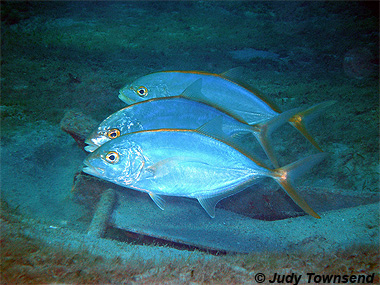
Carangoides bartholomaei
These large, classically almond-shaped fish tend to be pale yellow to blue-green and silvery. Although they grow to an average of 20 inches long, they’ve been measured as long as 40 inches at times. They are often caught by recreational fishers, but are considered high risk for carrying ciguatera toxins.
Order: Perciformes
Family: Carangidae
Genus: Carangoides
Species: bartholomaei
Common Names
English language common names are yellow jack, coolihoo, crevalle, green jack, jackfish, and yellowjack. Other common names include carangue gras (French), carangue grasse (French), carangue jaune (French), bok’ abou (Papiamento), garajuba (Portuguese), xarelete-azul (Portuguese), xaréu (Portuguese), xerelete-amarelo (Portuguese), atún (Spanish), cibi amarillo (Spanish), coginoa (Spanish), cojinoa amarilla (Spanish), cojinoa tumana (Spanish), cojinua amarilla (Spanish), guaymen (Spanish), guaymen amarillo (Spanish), jurelete (Spanish), and veiyu (Wayuu).
Importance to Humans
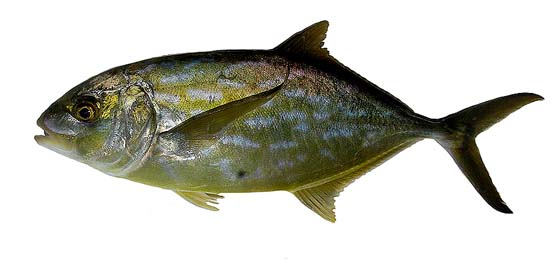
Considered a minor commercial species throughout its range, the yellow jack is taken by seines, trawls, and hook and line. Recreational fishers also take this species with bait and lures while trolling without specifically targeting the yellow jack. The flesh is considered fair to good for human consumption and is marketed fresh and salted. However it is classified as a high risk species due to its implication in ciguatera poisoning in humans. In fact, it was the first species outside the Indo-west Pacific to be a confirmed ciguatera carrier.
Conservation
The yellow jack has not been evaluated by the World Conservation Union (IUCN). The IUCN is a global union of states, governmental agencies, and non-governmental organizations in a partnership that assesses the conservation status of species.
Geographical Distribution
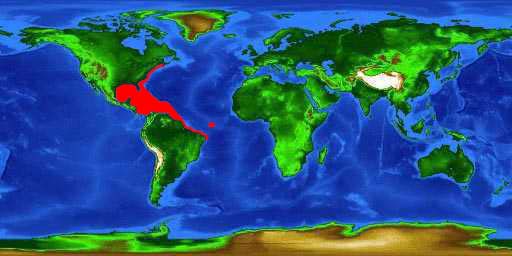
The yellow jack is found in the western Atlantic Ocean from Massachusetts to Bermuda and south through the Gulf of Mexico and the Caribbean including the West Indies and on to São Paulo, Brazil. In the eastern central Atlantic, this species has been documented at St. Paul’s Rocks.
Habitat
Residing on offshore reefs and in the sandy shallows of Caribbean islands as well as in open waters over the continental shelf, this jack is rare observed in shallow waters near the American continent. It lives at depths ranging from 0-164 feet (0-50 m). Juveniles of this species are often found nearshore in seagrass beds or associated with jellyfish or floating sargassum weed. Typically it is a solitary species but may at times been seen in small groups.
Biology
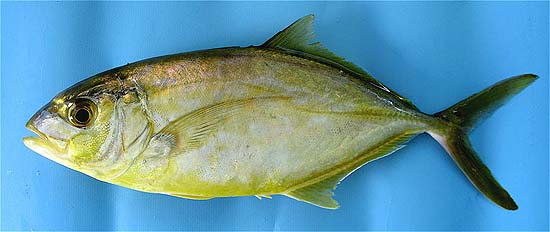
Distinctive Features
The yellow jack has a moderately deep, compressed elongate body which is typical of the genus Carangoides. The head is slightly curved from the snout to the nape; the eyes have well-developed adipose eyelids. The upper jaw does not reach the anterior margin of the eye. The dorsal fin is divided into two parts with the first containing 7 spines and the second with 1 spine followed by 25-28 soft rays. The anal fin is similar to the second dorsal fin in that the lobes are slightly pronounced; the pectoral fin is falcate and longer than the head. The caudal fin is forked and the caudal peduncle has bilateral paired keels present.
Coloration
This fish is pale yellow to green-blue dorsally, fading to silvery on the ventral side. Juvenile yellow jacks have 5 vertical bands which fade to blotches eventually disappearing as the fish matures. The fins often have a golden-brown tinge. Older fish tend to be more yellow in color with the largest specimens having brightly colored yellow fins.
Dentition
Both the upper and lower jaws contain narrow bands of villiform teeth with bands becoming wider anteriorly.
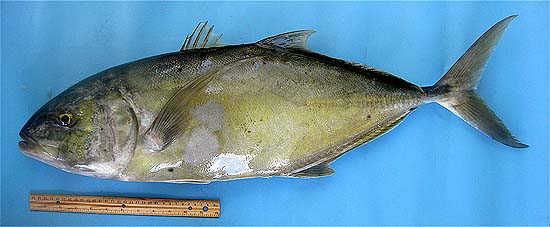
Size, Age, and Growth
A large fish, the yellow jack grows to a maximum reported length of just under 40 inches (100 cm) total length (TL) although this species typically reaches 20 inches (50.0 cm) TL. The maximum reported weight is 14.0 kg. Yellow jacks reach sexual maturity at 12 inches (30 cm) in length for males and 13 inches (32 cm) in length for females in the waters off Cuba. In contrast, off the coast of Jamaica, males reach sexual maturity at 9 inches (23 cm) in length.
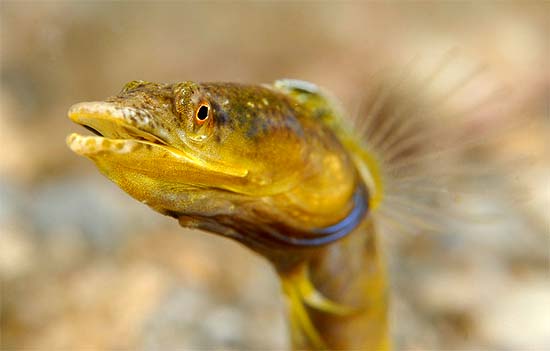
Food Habits
Yellow jacks feed on small fishes including the bluethroat pikeblenny (Chaenopsis ocellata), clown wrasse (Halichoeres maculipinna), yellowtail snapper (Ocyurus chrysurus), and parrotfish. They have also been observed “following” larger species to opportunistically forage as well as to scavenge scraps left by these larger fishes during feeding activity. Yellow jacks have also been reported as living in close relationship with spinner dolphins feeding off the dolphin’s waste products.Reproduction
Spawning activity takes place in offshore waters from February through October. It forms congregations of approximately 300 fishes with spawning occurring just before sunrise. When the fertilized pelagic eggs hatch, the juveniles live near the surface of the ocean amongst large mats of sargassum weed or jellyfish for protection from predation. The Gulf Stream current carries juvenile fish quite long distances and is probably responsible for this species being found as far north as Massachusetts.
Predators
Predators of the yellow jack include larger fishes, marine mammals, and birds including the brown noddy (Anous stolidus) and sooty tern (Sterna fuscata) which may feed on juveniles.
Parasites
Parasites of the yellow jack include the copepods Caligus chorinemi and Caligus robustus.
Taxonomy
The yellow jack was originally described as Caranx bartholomaei by the famous French taxonomist Georges Cuvier in 1833. The holotype was collected from St. Batholomew Island in the West Indies from which the species name is derived. This name was later changed to the currently valid Carangoides bartholomaei Cuvier 1833. This species is in the family Caragidae which includes jacks, pompanos, jack mackerels, and scads.
Prepared by: Cathy Bester